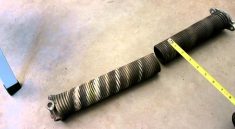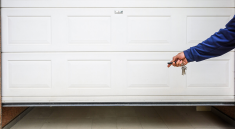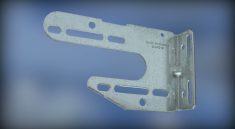Garage Doors and Parts – Most Vulnerable Garage Door Components are often overlooked until they cause a serious issue. A garage door may seem simple at first glance, but it consists of many moving parts that work together every day. When even one component begins to wear out or fail, it can lead to noise, inefficiency, or complete malfunction. Homeowners who understand which parts are likely to break first can take preventive steps and save time and money. Regular maintenance and early detection help extend the lifespan of your door and improve its safety. This article explores the five most failure-prone parts of a standard garage door system. These components are critical for smooth function and often take the most strain from daily use. Keeping an eye on their condition can prevent unexpected breakdowns and improve the security of your home. Let us examine the signs and issues related to each part in detail.
Torsion Springs Take the Brunt of the Load
Torsion springs handle the heavy lifting every time a garage door opens or closes. They counterbalance the weight of the door, which can easily exceed 100 pounds. These springs are wound tightly and endure extreme tension during operation. Over time, that tension leads to metal fatigue, especially when the door cycles multiple times a day. On average, torsion springs last between 10000 and 15000 cycles. When they break, the door may suddenly stop mid-motion or refuse to open at all. Some owners hear a loud snap when the spring fails, which is often the only warning. Replacing a broken torsion spring is a job best left to professionals due to the high risk of injury. Inspecting springs for rust, gaps, or distortion can help detect problems early. Lubrication also helps prolong their life. Since they carry most of the door’s weight, these components are some of the most vulnerable in the system.
“Read about: Too Many Tools, Too Little Space: How Cluttered Garages Begin”
Rollers and Tracks Can Derail Function
Rollers and tracks guide the garage door along a precise path during movement. When either part suffers damage or buildup, the door may jerk, wobble, or come off-track completely. Rollers are small wheels attached to the door panels, and they move inside metal tracks mounted on both sides. Dirt, debris, and wear can cause the rollers to stick or slide unevenly. Metal rollers without bearings tend to wear out faster than nylon ones, though both types need attention over time. Tracks must stay aligned and clean to prevent jamming. A bent or rusted track can pull the door out of balance or place extra strain on the opener. Regular cleaning and lubrication help maintain smooth performance. Watch for grinding noises or visible misalignment. While rollers are easy to replace individually, damaged tracks may require full section replacement. These parts, though small, play a large role in overall door stability.
Cables Fray and Snap Under Pressure
Lift cables work in tandem with torsion springs to control the door’s rise and fall. These steel cables connect to the bottom of the door and wind around drums mounted near the top. With repeated cycles, even strong steel can begin to fray or corrode. Moisture and road salt from cars can accelerate damage, especially in colder climates. A broken cable may leave the door lopsided or stuck halfway. Unlike some other issues, cable failure often happens without warning. Frayed ends or visible rust are signs that replacement is needed soon. If one cable fails, the door becomes unbalanced, placing extra load on the remaining cable and the opener. Never try to fix or adjust cables without proper tools and training. They carry high tension and can snap dangerously. Cables are responsible for safe, controlled motion and should be inspected as part of routine garage maintenance at least twice a year.
“Read more: Inside the Summer Fancy Food Show: 2025’s Hottest Food Trends”
Garage Door Openers Face Mechanical and Electrical Wear
The opener serves as the brain and muscle of automatic garage door systems. Inside the opener, gears, motors, sensors, and circuit boards work together to move the door safely. Over time, motor gears can strip, chains can loosen, or sensors may misalign. Frequent power surges or outages can also affect the circuit board. Signs of trouble include sluggish response, flickering lights, or inconsistent operation. Wireless remotes may stop working, or safety sensors may fail to detect obstacles. Most opener models last between 10 and 15 years, depending on usage. Dust, vibration, and moisture can all shorten that lifespan. Basic maintenance includes tightening hardware, checking chains or belts, and cleaning sensors. Replacing worn gears or upgrading to newer smart models can improve performance. Since the opener powers every movement of the door, it deserves regular attention and cleaning. Malfunction in this area could lead to a nonresponsive or stuck garage door.
Weather Seals and Hinges Suffer from Exposure
Weather seals and panel hinges are often overlooked but essential to the long-term health of a garage door system. Seals around the bottom and sides keep out water, dust, and insects. Over time, rubber or vinyl seals crack, shrink, or detach due to exposure to sun and moisture. A damaged seal allows drafts and pests into your garage and reduces insulation. Hinges connect the panels and allow the door to bend during opening and closing. These metal parts experience constant motion and stress. Rust, misalignment, or cracking can weaken them. Noisy operation or wobbling panels often signal hinge problems. Keeping hinges clean and lubricated prevents rust and wear. Seal replacement is easy and low-cost but often neglected until weather damage appears. Both parts are simple yet vital. They preserve energy efficiency, structural integrity, and quiet operation. Monitoring them regularly helps ensure that the garage remains safe, clean, and functional year-round.



